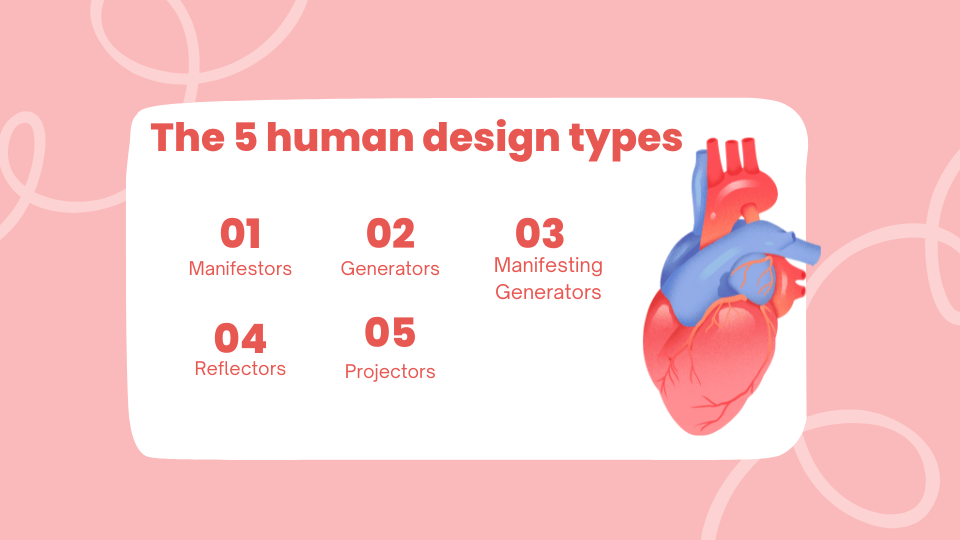Understanding Human Design Types & Strategy
Human Design is a system that combines principles from astrology, the I Ching, the Kabbalah, the Hindu-Brahmin chakra system, and quantum physics to provide a unique approach to understanding human behavior and decision-making. It was developed by Robert Allan Krakower, who later changed his name to Ra Uru Hu, in 1987.
According to Human Design, each person has a specific energetic blueprint or “design”. The time, date, and location of their birth determine their type. This design consists of various elements, including nine centers (representing different aspects of human experience), 64 hexagrams (derived from the I Ching), and the arrangement of gates and channels (representing specific energies and traits).

The purpose of Human Design is to help individuals gain insight into their strengths, weaknesses, and life purpose by understanding their unique design. It offers a framework for understanding one’s personality, decision-making strategy, and the ways in which one interacts with others and the world. It provides a detailed map of an individual’s energetic makeup and offers guidance on how to align with their true nature and make decisions in accordance with their design.
Human Design readings typically involve generating a “body graph” or “chart” based on an individual’s birth information. This chart provides a visual representation of the individual’s design, including the positions of the centers, gates, channels, and other elements. A trained Human Design analyst or practitioner can interpret this chart and provide insights and guidance based on the individual’s design.
It’s important to note that Human Design is not scientifically validated and is considered by many to be a pseudoscience. While some people find value and resonance in the system, it is important to approach it with an open mind and a critical perspective.
How does human design work?
Human Design is a synthesis of Eastern and Western Astrology, the Chinese I Ching, the Kabbalah, the Hindu-Brahman chakra model, and quantum physics. It proposes that people’s personalities and life paths can be mapped out using this information. Here’s a basic overview of how it works:
To understand how Human Design works, let’s break down its key components:
Birth Information:
The first step is gathering the person’s birth information, which includes the date, time, and place of birth.
Human Design Chart:
Using this birth information, a Human Design Chart, also known as a BodyGraph, is created. This chart is a visual representation of a person’s life potential and challenges.
Centers:
Human Design identifies nine centers that represent different aspects of human experiences, such as the head, Ajna (mind), throat, heart, and others. Each center can be either defined (colored in on the chart) or undefined (white on the chart). Defined centers indicate consistent energy and traits, while undefined centers suggest a receptivity to external energies and a potential for influence from others.
Gates and Channels:
The body graph, which is the visual representation of an individual’s Human Design, contains 64 gates derived from the I Ching, a Chinese divination text. These gates are connected by channels, forming a network of energetic pathways. Each gate and channel represents a specific energy or trait, and their positions in the body graph indicate areas of focus and potential expression.
Type:
Human Design categorizes individuals into five different types: Manifestor, Generator, Manifesting Generator, Projector, and Reflector. Each type has a specific strategy for making decisions and engaging with the world. For example, Generators and Manifesting Generators are designed to respond to life through a process of “sacral response” and listen to their gut instincts, while Projectors are meant to wait for invitation and recognition before exerting their energy.
Authority:
Authority refers to the decision-making process based on an individual’s internal guidance system. Human Design recognizes various authorities, including emotional, sacral, splenic, egoic, and more. Each authority type corresponds to a different center and provides a recommended approach for making decisions aligned with one’s authentic self.
Profile:
The profile in Human Design consists of two numbers, such as 2/4 or 6/2, which represent archetypal energies and characteristics. These numbers provide additional insights into an individual’s life purpose, role, and interactions with others.
When someone receives a Human Design reading, a trained practitioner or analyst generates their body graph based on their birth information. This graph provides a visual representation of their energetic blueprint. The practitioner then interprets the chart, explaining the individual’s defined and undefined centers, gates, channels, type, authority, and profile. The interpretation aims to offer guidance on how to align with one’s true nature, make decisions, and navigate relationships and life challenges.
The 5 human design types.

1. Manifestors:
In Human Design, Manifestors are one of the five types, each representing a distinct strategy for engaging with the world. Manifestors make up approximately 8% of the population. Here are some key characteristics and strategies associated with Manifestors:
Strategy:
The strategy for Manifestors is to inform. Manifestors are encouraged to inform those who may be affected by their actions before taking action. By informing others, Manifestors create a sense of harmony and allow for a smoother flow of energy. However, Manifestors have the inherent freedom to act without seeking permission or consensus.
Initiators and Innovators:
Manifestors have a natural ability to initiate and create. They possess an independent and self-directed nature, often driven by a strong sense of personal will. Manifestors are here to bring new ideas, innovations, and initiatives into the world, often manifesting change and transformation through their actions.
Independent Nature:
Manifestors thrive when they have the freedom to act and make decisions autonomously. They may find it challenging to conform to authority or follow traditional societal expectations. Manifestors are designed to be self-guided and are best suited to create their path.
Impactful and Efficient:
Manifestors are efficient and can accomplish tasks quickly. They have bursts of energy and vitality that can propel them forward when they are aligned with their true desires and passions. Their impact on others can be significant, and they may have a strong presence and influence in their environments.
Informing Others:
Informing is a vital aspect of the Manifestor strategy. By openly communicating their plans and actions, Manifestors can minimize resistance and avoid unnecessary friction with others. This allows for a smoother execution of their initiatives and fosters better collaboration and understanding.
Energy Waves:
Manifestors have a unique energy wave pattern, characterized by periods of intense activity followed by periods of rest and withdrawal. These cycles are natural for Manifestors and should be honored to maintain their well-being and balance.
2. Generators
Generators are one of the five types in Human Design and make up the majority of the population, comprising about 70%. They have a unique strategy for engaging with the world. Here are some key characteristics and strategies associated with Generators:
Strategy:
The strategy for Generators is to wait to respond. Instead of initiating action, Generators are advised to wait for something or someone outside of themselves to trigger a response. This response can be a gut feeling, a sense of satisfaction, or an inner knowing that signals alignment with their authentic path.
Energy and Life Force:
Generators have a vast reservoir of life force energy within them. They are designed to have sustainable energy and endurance for tasks and activities that truly resonate with them. When engaged in something that lights up their passion and sparks their interest, Generators can experience a state of flow and productivity.
Gut Instinct:
The gut or sacral center is the authority for Generators. It is through their gut instinct that they can discern whether a situation or opportunity is correct for them. Generators need to pay attention to their gut response, which can manifest as a feeling of expansion (a “yes”) or contraction (a “no”).
Satisfaction and Frustration:
Generators thrive when they are engaged in work or activities that bring them a sense of deep satisfaction and fulfillment. When they are aligned with their true passions and respond to life with a sense of enthusiasm, they can experience a fulfilling and joyful existence. On the other hand, if they find themselves in situations that don’t resonate or drain their energy, they may experience frustration and a lack of fulfillment.
Work and Mastery:
Generators have a natural inclination towards mastery in their chosen endeavors. They are designed to invest their energy consistently over time, honing their skills and becoming experts in their fields. Through dedicated practice and commitment, Generators can achieve a deep level of expertise and fulfillment in their work.
Openness and Aura:
Generators have an open and enveloping aura that draws opportunities and interactions toward them. Their energy can be attractive to others, and they may receive invitations and inquiries from outside sources. Generators need to discern which opportunities align with their authentic response and which ones are not in their best interest.
3. Manifesting Generators:
Manifesting Generators combine the traits of both Manifestors and Generators. They are energetic, multi-passionate, and action-oriented. They have fast-paced energy and often engage in multiple activities simultaneously. Their strategy is to respond, similar to Generators, but with a more rapid and spontaneous approach. Manifesting Generators are designed to move quickly and can experience satisfaction through swift decision-making and efficiency.
4. Projectors:
Projectors are one of the five types of Human Design and makeup approximately 20% of the population. They have unique characteristics, strategies, and ways of engaging with the world. Here’s an overview of Projectors in Human Design:
Strategy:
The strategy for Projectors is to wait for invitations and recognition. Projectors are not designed to initiate an action like Manifestors or Generators. Instead, they are here to wait for the correct recognition and invitation into activities, relationships, and work projects. By waiting for the invitation, Projectors can share their wisdom, guidance, and insights effectively.
Observers and Guides:
Projectors have a natural ability to observe and perceive deeply into others and systems. They can see the potential and talents in others, making them excellent guides and managers. Projectors often excel in roles where they can offer their expertise and guidance to support and uplift others.
Penetrating Aura:
Projectors have a focused and penetrating aura that allows them to deeply understand and analyze the energy of those around them. Their aura can be felt by others, making them naturally influential and able to impact their environment. However, it’s important for Projectors to use their energy wisely and be mindful of their boundaries to avoid taking on the energy of others.
Sensitivity to Energy:
Projectors are highly sensitive to energy and can easily become overwhelmed if they are not in the right environments or surrounded by supportive people. They need a balance of rest, solitude, and meaningful interactions to maintain their well-being and energy levels. Understanding their sensitivity and honoring their needs is crucial for Projectors to thrive.
Unique Path and Timing:
Projectors often have a unique life path that doesn’t necessarily follow traditional societal expectations. They may need to experiment, explore, and find their own way. Projectors may experience challenges when they try to push themselves or conform to the energy of others. Embracing their own rhythm and timing is key to their success and fulfillment.
Self-Worth and Recognition:
Projectors thrive when they are recognized and valued for their unique gifts and expertise. They need to feel seen and appreciated for their contributions. It’s important for Projectors to cultivate self-worth independent of external recognition and to surround themselves with people who appreciate and respect their insights.
5. Reflectors:
Reflectors are the rarest type, comprising only about 1% of the population. They have a highly sensitive and open energetic system, which enables them to act as mirrors of the collective. Their strategy is to wait for a full lunar cycle (approximately 28 days) before making important decisions. Reflectors have the ability to perceive and reflect the energies of their environment, providing unique insights and perspectives. They thrive in environments that support their well-being and offer them a sense of clarity and security.
Final Thoughts
Human Design types offer a framework for understanding our unique energetic makeup, decision-making strategies, and ways of engaging with the world. Whether you identify as a Manifestor, Generator, Manifesting Generator, Projector, or Reflector, understanding your type and its associated strategies can provide valuable insights for personal growth and navigating life.
However, it’s important to remember that Human Design is not scientifically validated and should be approached with an open mind and a critical perspective. While some people resonate deeply with their Human Design type and find it helpful in guiding their choices and understanding themselves, others may not resonate as strongly or may have different interpretations of their experiences.
It’s also worth noting that Human Design is just one tool among many available for self-discovery and personal development. It can use as a tool for self-reflection, but it shouldn’t see as an absolute determinant of one’s identity or capabilities. Each individual is unique and multifaceted, and Human Design is just one lens through which we can gain insights into ourselves and our interactions with the world.
Ultimately, whether or not you find value in Human Design types is a personal decision.f you want to dive deeper into Human Design, consider consulting a trained analyst or practitioner. They can provide a thorough, personalized interpretation of your chart. Remember to approach it with curiosity, openness, and a willingness to integrate the information that resonates with you into your own journey of self-discovery.






